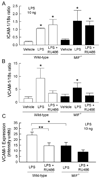Independent roles of macrophage migration inhibitory factor and endogenous, but not exogenous glucocorticoids in regulating leukocyte trafficking
- PMID: 19905972
- PMCID: PMC3070174
- DOI: 10.3109/10739680903210421
Independent roles of macrophage migration inhibitory factor and endogenous, but not exogenous glucocorticoids in regulating leukocyte trafficking
Abstract
Objectives: Macrophage migration inhibitory factor (MIF) promotes leukocyte recruitment and antagonizes the anti-inflammatory effects of glucocorticoids (GC). The aim of this study was to examine whether interaction between MIF and GC underlies the ability of MIF to promote leukocyte-endothelial cell (EC) interactions.
Methods: Intravital microscopy was used to assess leukocyte-EC interactions in wild-type and MIF(-/-) mice following treatment with lipopolysaccharide (LPS), the GC dexamethasone, and inhibition of endogenous GC, using the GC-receptor antagonist, RU486.
Results: Dexamethasone reduced LPS-induced leukocyte interactions in wild-type mice to levels similar to those observed in MIF(-/-) mice not treated with dexamethasone, whereas in MIF(-/-) mice, leukocyte interactions were not further inhibited by dexamethasone. RU486 increased LPS-induced leukocyte adhesion and emigration to a similar extent in both wild-type and MIF(-/-) mice, indicating that endogenous GC exert a similar inhibitory effect on leukocyte trafficking in wild-type and MIF(-/-) mice. Both MIF deficiency and RU486 treatment reduced VCAM-1 expression, while neither treatment modulated expression of ICAM-1 or chemokines CCL2, KC, and MIP-2.
Conclusions: These results suggest that endogenous MIF and GC regulate leukocyte-EC interactions in vivo reciprocally but through predominantly independent mechanisms, and that the anti-inflammatory effect of MIF deficiency is comparable to that of exogenous GC.
Figures





Similar articles
-
Macrophage migration inhibitory factor and CD74 regulate macrophage chemotactic responses via MAPK and Rho GTPase.J Immunol. 2011 Apr 15;186(8):4915-24. doi: 10.4049/jimmunol.1003713. Epub 2011 Mar 16. J Immunol. 2011. PMID: 21411731 Free PMC article.
-
Reduced leukocyte-endothelial cell interactions in the inflamed microcirculation of macrophage migration inhibitory factor-deficient mice.Arthritis Rheum. 2004 Sep;50(9):3023-34. doi: 10.1002/art.20470. Arthritis Rheum. 2004. PMID: 15457472
-
Macrophage migration inhibitory factor increases leukocyte-endothelial interactions in human endothelial cells via promotion of expression of adhesion molecules.J Immunol. 2010 Jul 15;185(2):1238-47. doi: 10.4049/jimmunol.0904104. Epub 2010 Jun 16. J Immunol. 2010. PMID: 20554956
-
Macrophage migration inhibitory factor and glucocorticoid sensitivity.Rheumatology (Oxford). 2006 Aug;45(8):937-43. doi: 10.1093/rheumatology/kel142. Epub 2006 May 16. Rheumatology (Oxford). 2006. PMID: 16705047 Review.
-
Macrophage migration inhibitory factor (MIF): a glucocorticoid counter-regulator within the immune system.Crit Rev Immunol. 1997;17(1):77-88. doi: 10.1615/critrevimmunol.v17.i1.30. Crit Rev Immunol. 1997. PMID: 9034724 Review.
Cited by
-
Control of Leukocyte Trafficking by Stress-Associated Hormones.Front Immunol. 2019 Jan 11;9:3143. doi: 10.3389/fimmu.2018.03143. eCollection 2018. Front Immunol. 2019. PMID: 30687335 Free PMC article. Review.
-
Arrest Functions of the MIF Ligand/Receptor Axes in Atherogenesis.Front Immunol. 2013 May 16;4:115. doi: 10.3389/fimmu.2013.00115. eCollection 2013. Front Immunol. 2013. PMID: 23720662 Free PMC article.
-
Toll-like receptor 4: innate immune regulator of neuroimmune and neuroendocrine interactions in stress and major depressive disorder.Front Neurosci. 2014 Sep 30;8:309. doi: 10.3389/fnins.2014.00309. eCollection 2014. Front Neurosci. 2014. PMID: 25324715 Free PMC article. Review.
-
Early, low-dose, short-term methylprednisolone decreased the mortality in critical COVID-19 patients: A multicenter retrospective cohort study.J Infect. 2021 Apr;82(4):84-123. doi: 10.1016/j.jinf.2020.11.001. Epub 2020 Nov 8. J Infect. 2021. PMID: 33176176 Free PMC article. No abstract available.
-
Macrophage migration inhibitory factor and CD74 regulate macrophage chemotactic responses via MAPK and Rho GTPase.J Immunol. 2011 Apr 15;186(8):4915-24. doi: 10.4049/jimmunol.1003713. Epub 2011 Mar 16. J Immunol. 2011. PMID: 21411731 Free PMC article.
References
-
- Aeberli D, Yang YH, Mansell A, Santos L, Leech M, Morand EF. Endogenous macrophage migration inhibitory factor modulates glucocorticoid sensitivity in macrophages via effects on MAP kinase phosphatase-1 and p38 MAP kinase. FEBS Lett. 2006;580:974–981. - PubMed
-
- Bernhagen J, Calandra T, Mitchell RA, Martin SB, Tracey KJ, Voelter W, Manogue KR, Cerami A, Bucala R. MIF is a pituitary-derived cytokine that potentiates lethal endotoxaemia. Nature. 1993;365:756–759. - PubMed
-
- Bernhagen J, Krohn R, Lue H, Gregory JL, Zernecke A, Koenen RR, Dewor M, Georgiev I, Schober A, Leng L, Kooistra T, Fingerle-Rowson G, Ghezzi P, Kleemann R, McColl SR, Bucala R, Hickey MJ, Weber C. MIF is a noncognate ligand of CXC chemokine receptors in inflammatory and atherogenic cell recruitment. Nat Med. 2007;13:587–596. - PubMed
Publication types
MeSH terms
Substances
Grants and funding
LinkOut - more resources
Full Text Sources
Medical
Miscellaneous

